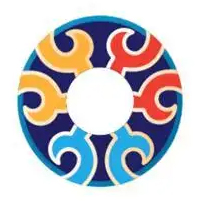Cloisonné - Beijing's Treasure
Jingtailan is a unique craft in Beijing, known for its magnificent and elegant, and has a high reputation at home and abroad. Jingtailan products are one of the representative works of Jingtailan craftsmanship since the founding of the People's Republic of China, with their unique shapes, patterns, colors, and exquisite processing techniques.
"Peacock Teapot"
"Peacock Teapot" is one of the representative works of Jingtailan products. It features a peacock as its image, with a unique and vivid overall teapot shape. The spout is modeled after the head and neck of a peacock, decorated with traditional fish scale brocade patterns and innovative feather brocade patterns. The mouth, lid, and base of the teapot are adorned with beautiful decorations, with smooth lines that leave a lasting impression. The top cover knob is shaped like two metal peacocks in an open screen shape, fully showcasing the superior level of Jingtailan artistry. The glaze colors are primarily coral red, complemented by blue-green and gold, creating a harmonious and elegant appearance.
Enamel Thread Winding Peony Pattern Rangcao Vase
This late Qing Dynasty cloisonne work is now housed in the Palace Museum. The peony flowers painted on the vase have a strong three-dimensional effect, giving a visually prominent effect. The intertwined peony pattern is a popular decorative motif in the Ming and Qing dynasties, with the peony branches on the picture being twisted into continuous wavy lines, decorated with flower leaves. This vase is glazed in yellow color, with colored intertwined double-horned peony flowers and red bats. The intertwined peony and bats together symbolize great fortune and continuous prosperity. There are two coiled dragons on the shoulder of this vase, which are symbols of imperial power and also the characteristics of imperial cloisonne enamelware.
Interlaced lotus pattern tripod incense burner
This enamelware from the Yuan Dynasty is a collection of the Qing Palace and is now housed in the National Palace Museum in Taipei. The furnace is round with double handles and a drum-shaped body, resembling a bronze tripod, simple and solemn. The upper part of the furnace body is divided into two parts by a golden string pattern. The upper part of the furnace body is green enamel with 12 white chrysanthemums. The lower part is blue enamel with 6 intertwined lotus flower patterns. The three legs are all blue enamel with colorful chrysanthemum patterns. The decorative pattern features blooming intertwined lotus flowers, with bold and powerful lines, delicate and clean enamel texture, and a glossy glaze. This furnace is a representative work of the enamelware from the Yuan Dynasty.
Floral pattern flower wine container with spade-shaped leaves
This Ming Dynasty flowerpot is in three sections, with a blue enamel glaze and decorated with colorful intertwined lotus patterns. The flowerpot has a simple and elegant shape, with smooth lines and vibrant colors. It was originally a decoration in the Ming Dynasty imperial study, modeled after Shang and Zhou bronze vessels, with a refined color scheme. It was previously converted into a table lamp, with a hole punched in the bottom. The original inscription of 'Jingtai year made' on the bottom of the flowerpot is partially damaged due to the punched hole. This artwork embodies the simple beauty of the flowerpot and the exquisite craftsmanship of Ming Dynasty imperial cloisonné enamel.
Tianji vessel
This Jingtailan artwork from the Qing Qianlong period features an image of a proud and upright Tianji. It carries a chi-ear vessel on its back, with spread wings attached to the body, and a pair of hollow double wheels on the footrest. The long tail hangs down and curls inward, with a small Tianji with copper-gilt feathers standing on the inner side of the tail. The chest of the Tianji is adorned with cloud-shaped enamel decorations, with a rectangular copper-gilt plaque embedded in the middle, engraved with the inscription 'Made in the Qianlong reign'. The overall piece is made of red copper, with cloisonné patterns filled with enamel colors and gilded copper exposed. This artwork has a beautiful shape and rich colors, showcasing the exquisite craftsmanship in cloisonné production during the Qianlong period.
Beast-faced pattern lifting pot
This is a lifting pot made during the Qianlong period of the Qing dynasty, enameled in blue with filigree patterns. A beast face is decorated on the center of the neck's front and back, flanked by flying phoenixes; the belly is adorned with double phoenixes flying towards each other. This pot has an ancient and beautiful shape, smooth lines, and brilliant colors. The surface of the pot also features the sunken-engraved characters 'Made in the Qianlong Year'. This pot reflects the exquisite level of filigree enamel craftsmanship in the middle of the Qing dynasty.

